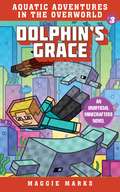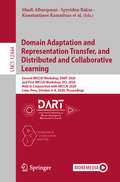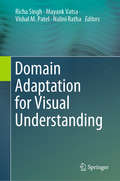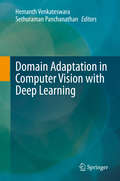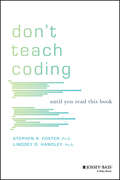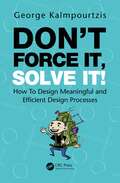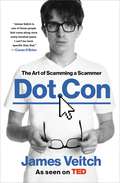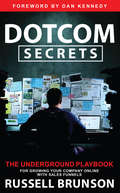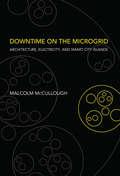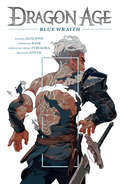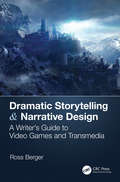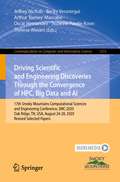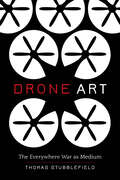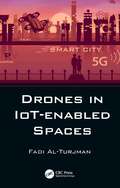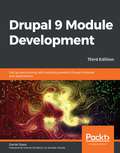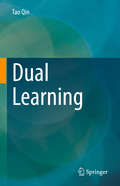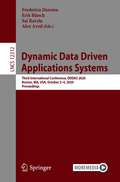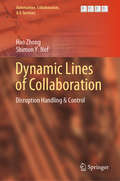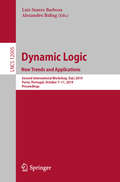- Table View
- List View
Dolphin's Grace: An Unofficial Minecrafters Novel (Aquatic Adventures in the Overworld #3)
by Maggie MarksFollow along with brothers Mason and Asher in the third Aquatic Adventures in the Overworld book! Brothers Mason and Asher have only ever known the comfort of dry land in the Overworld. But when a terrifying shipwreck leaves them stranded, their new friend Luna urges them to safe haven—underwater. In each story of the all-new series for Minecrafters, Aquatic Adventures in the Overworld, this unlikely trio must make the choice of staying in the world they know best and risk death, or voyaging into an unknown world where anything could happen. Follow their journey as Mason, Asher, and Luna face incredible obstacles and discover strength they never knew they had in Aquatic Adventures in the Overworld. When Asher doesn&’t return from his hunt for buried treasure, Mason wonders what became of his brother. Then Luna appears, insisting that the pod of dolphins swimming nearby have a message for Mason. Do they know where Asher is? To find out more, Mason and Luna have to first earn the dolphins&’ trust. But when danger strikes, Mason wonders—is it too late to save his brother, and can he and Luna save the dolphins, too?
Domain Adaptation and Representation Transfer, and Distributed and Collaborative Learning: Second MICCAI Workshop, DART 2020, and First MICCAI Workshop, DCL 2020, Held in Conjunction with MICCAI 2020, Lima, Peru, October 4–8, 2020, Proceedings (Lecture Notes in Computer Science #12444)
by M. Jorge Cardoso Shadi Albarqouni Spyridon Bakas Bennett Landman Fausto Milletari Nicola Rieke Ziyue Xu Konstantinos Kamnitsas Wenqi Li Holger Roth Daguang XuThis book constitutes the refereed proceedings of the Second MICCAI Workshop on Domain Adaptation and Representation Transfer, DART 2020, and the First MICCAI Workshop on Distributed and Collaborative Learning, DCL 2020, held in conjunction with MICCAI 2020 in October 2020. The conference was planned to take place in Lima, Peru, but changed to an online format due to the Coronavirus pandemic. For DART 2020, 12 full papers were accepted from 18 submissions. They deal with methodological advancements and ideas that can improve the applicability of machine learning (ML)/deep learning (DL) approaches to clinical settings by making them robust and consistent across different domains.For DCL 2020, the 8 papers included in this book were accepted from a total of 12 submissions. They focus on the comparison, evaluation and discussion of methodological advancement and practical ideas about machine learning applied to problems where data cannot be stored in centralized databases; where information privacy is a priority; where it is necessary to deliver strong guarantees on the amount and nature of private information that may be revealed by the model as a result of training; and where it's necessary to orchestrate, manage and direct clusters of nodes participating in the same learning task.
Domain Adaptation for Visual Understanding
by Vishal M. Patel Richa Singh Mayank Vatsa Nalini RathaThis unique volume reviews the latest advances in domain adaptation in the training of machine learning algorithms for visual understanding, offering valuable insights from an international selection of experts in the field. The text presents a diverse selection of novel techniques, covering applications of object recognition, face recognition, and action and event recognition.Topics and features: reviews the domain adaptation-based machine learning algorithms available for visual understanding, and provides a deep metric learning approach; introduces a novel unsupervised method for image-to-image translation, and a video segment retrieval model that utilizes ensemble learning; proposes a unique way to determine which dataset is most useful in the base training, in order to improve the transferability of deep neural networks; describes a quantitative method for estimating the discrepancy between the source and target data to enhance image classification performance; presents a technique for multi-modal fusion that enhances facial action recognition, and a framework for intuition learning in domain adaptation; examines an original interpolation-based approach to address the issue of tracking model degradation in correlation filter-based methods.This authoritative work will serve as an invaluable reference for researchers and practitioners interested in machine learning-based visual recognition and understanding.
Domain Adaptation in Computer Vision with Deep Learning
by Sethuraman Panchanathan Hemanth VenkateswaraThis book provides a survey of deep learning approaches to domain adaptation in computer vision. It gives the reader an overview of the state-of-the-art research in deep learning based domain adaptation. This book also discusses the various approaches to deep learning based domain adaptation in recent years. It outlines the importance of domain adaptation for the advancement of computer vision, consolidates the research in the area and provides the reader with promising directions for future research in domain adaptation.Divided into four parts, the first part of this book begins with an introduction to domain adaptation, which outlines the problem statement, the role of domain adaptation and the motivation for research in this area. It includes a chapter outlining pre-deep learning era domain adaptation techniques. The second part of this book highlights feature alignment based approaches to domain adaptation. The third part of this book outlines image alignment procedures for domain adaptation. The final section of this book presents novel directions for research in domain adaptation. This book targets researchers working in artificial intelligence, machine learning, deep learning and computer vision. Industry professionals and entrepreneurs seeking to adopt deep learning into their applications will also be interested in this book.
Dominando el Podcasting: Cómo iniciar, hacer crecer y monetizar tu podcast
by Adidas WilsonUn podcast es, básicamente, algo parecido a una radio online. La única diferencia es que presenta ciertas ventajas, como la posibilidad de escucharlo cuando lo desees en lugar de tener que hacerlo en un determinado día u horario. Si bien los podcasts se parecen a los programas de entrevistas de la radio, son al mismo tiempo muy diferentes, como sucede con los videos de YouTube y la televisión. Un podcast se describe mejor como una serie de episodios almacenados en archivos de audio, del mismo tipo de los que usas para escuchar música en tu smartphone o en tu computadora . Al igual que cualquier otro programa de entrevistas de radio o televisión, un podcast generalmente trata sobre una categoría en particular: puede ser juegos, terror, entretenimiento, deportes, política, etc. En cada episodio, se aborda un tema de esa categoría. Puedes optar por suscribirte al podcast (generalmente es gratuito) o escuchar un tema en especial. Pod Saves America es un podcast muy popular que aborda las noticias políticas en forma progresiva. Los anfitriones son Daniel Pfeiffer, Jon Lovett, Tommy Vietor y Jon Favreau. Suelen invitar a expertos para que compartan sus opiniones. Los episodios se centran principalmente en cuestiones políticas como ser la reforma fiscal o la asistencia sanitaria. Otro podcast es The Critical Role.
Dominando el iPad de Apple: iOS 12
by Adidas WilsonEstá bien sentirse abrumado luego de comprar un iPad, es una sensación bastante común debido a todo lo que tienes que aprender a hacer con tu nuevo dispositivo. Sin embargo, eso no debería intimidarte, en poco tiempo te convertirás en un pro usándolo. Las siguientes indicaciones te ayudarán a empezar. Lo esencial para cualquier dispositivo es descargar la última actualización de software, si es algo que su sistema permite. Las actualizaciones eliminan los molestos errores o bugs, mantienen tu dispositivo trabajando con fluidez y ahorran la duración de la batería, haciendo que tu iPad funcione con mayor eficiencia. No hay conocimiento de algún virus que afecte a los iPads, además de que Apple hace una revisión de todas sus aplicaciones, lo que hace muy extraña la aparición de algún software malicioso o malware. A pesar de todo, el malware puede afectar cualquier dispositivo y las actualizaciones de software incrementan la seguridad de tu equipo. Apple ha presentado la nueva versión de iOS, el iOS 12. La versión estará disponible tanto para iPads como para iPhones de forma gratuita a partir de finales de 2018. Más adelante encontrarás algunas de las mejores características que experimentarás con la nueva versión. Apple confirmó que va a duplicar el rendimiento para aumentar la velocidad y la capacidad de respuesta en los iPads y iPhones.
Dominando o Podcasting
by Adidas WilsonBasicamente, um podcast é como uma forma online de rádio. A única diferença é que você tem certas vantagens em um podcast, como a capacidade de ouvir quando quiser, em vez de em um determinado horário ou dia. Embora os podcasts sejam um pouco como os talk shows de rádio, eles são, ao mesmo tempo, muito diferentes - como vídeos do YouTube e televisão. Um podcast é melhor descrito como uma série de episódios armazenados em arquivos de áudio, do mesmo tipo que você usa para músicas em seu smartphone ou laptop. Assim como qualquer outro programa de entrevistas de rádio ou televisão, um podcast geralmente é baseado em um tema - pense em jogos, horror, entretenimento, esportes, política etc. A cada episódio, um assunto desse tema é abordado. Você pode optar por assinar o podcast (normalmente gratuito) ou ouvir um assunto específico. Um podcast popular nos EUA é o Pod Salva a América (Pod Saves America). que aborda as notícias políticas progressivamente. No Brasil, podemos citar o Ideias (da Gazeta do Povo), com diferentes apresentadores, dentre eles o conhecido jornalista Alexandre Garcia. Os anfitriões são Daniel Pfeiffer, Jon Lovett, Tommy Vietor e Jon Favreau. Eles, frequentemente, convidam especialistas como convidados para dar suas opiniões. Os episódios se concentram principalmente em questões políticas, como reforma tributária ou assistência médica. Outro podcast americano é o Papel Crítico (Critical Role) .
Dominar el podcasting para principiantes: Cómo iniciar un negocio de podcasting rentable desde casa
by Shasha Taylor¿Quieres comenzar un podcast como si fueras un profesional y nos sabes por dónde comenzar? ¿Quieres monetizar tu podcast, pero no sabes cómo hacerlo? Entonces, este libro está especialmente diseñado para ti, creado por alguien que una vez estuvo en tus zapatos, pero superó las dificultades para convertirse en una podcaster de éxito. ¿Te preguntas cómo proyectar tu voz, nombre y contenidos al mundo entero y conseguir dinero? Crear un podcast es un sueño hecho realidad. No importa tu tipo de empresa o tu contenido, hay una especialidad para ti y mas ahora que el podcast tiene más de 5 millones de oyentes tan solo en EE. UU. y aumenta cada día. Sabemos que alguna vez has oído algo de los podcast, pero no lo sabes todo. No te preocupes, cuenta con nosotros. ¿No sabes cómo conseguir grandes equipos para conseguirlo? No le des más vueltas. Hemos comprimido en este libro toda la información para que aprendas a producir podcasts baratos entre las cuatro paredes de tu habitación sin tener que comprar grandes herramientas y equipos. Sí, ¡es así de simple! Debes crear tu canal y una comunidad de oyentes a través de la producción de contenidos curados y te devolverán su apoyo, donaciones y promociones. ¿No sabes cómo curar esos contenidos? Este libro te ayuda y acompaña en cada fase desde preparar el equipo para grabar, editar, crear conexiones y ¡al final las fases de producción y postproducción! ¡Esto es el podcasting hecho realidad solo para ti!
Don't Read the Comments
by Eric SmithDivya Sharma is a queen. Or she is when she’s playing Reclaim the Sun, the year’s hottest online game. <P><P>Divya—better known as popular streaming gamer D1V—regularly leads her #AngstArmada on quests through the game’s vast and gorgeous virtual universe. But for Divya, this is more than just a game. Out in the real world, she’s trading her rising-star status for sponsorships to help her struggling single mom pay the rent. <P><P>Gaming is basically Aaron Jericho’s entire life. Much to his mother’s frustration, Aaron has zero interest in becoming a doctor like her, and spends his free time writing games for a local developer. At least he can escape into Reclaim the Sun—and with a trillion worlds to explore, disappearing should be easy. But to his surprise, he somehow ends up on the same remote planet as celebrity gamer D1V. <P><P>At home, Divya and Aaron grapple with their problems alone, but in the game, they have each other to face infinite new worlds…and the growing legion of trolls populating them. Soon the virtual harassment seeps into reality when a group called the Vox Populi begin launching real-world doxxing campaigns, threatening Aaron’s dreams and Divya’s actual life. The online trolls think they can drive her out of the game, but everything and everyone Divya cares about is on the line…And she isn’t going down without a fight.
Don't Teach Coding: Until You Read This Book
by Lindsey D. Handley Stephen R. FosterThe definitive resource for understanding what coding is, designed for educators and parents Even though the vast majority of teachers, parents, and students understand the importance of computer science in the 21st century, many struggle to find appropriate educational resources. Don't Teach Coding: Until You Read This Book fills a gap in current knowledge by explaining exactly what coding is and addressing why and how to teach the subject. Providing a historically grounded, philosophically sensitive description of computer coding, this book helps readers understand the best practices for teaching computer science to their students and their children. The authors, experts in teaching computer sciences to students of all ages, offer practical insights on whether coding is a field for everyone, as opposed to a field reserved for specialists. This innovative book provides an overview of recent scientific research on how the brain learns coding, and features practical exercises that strengthen coding skills. Clear, straightforward chapters discuss a broad range of questions using principles of computer science, such as why we should teach students to code and is coding a science, engineering, technology, mathematics, or language? Helping readers understand the principles and issues of coding education, this book: Helps those with no previous background in computer science education understand the questions and debates within the field Explores the history of computer science education and its influence on the present Views teaching practices through a computational lens Addresses why many schools fail to teach computer science adequately Explains contemporary issues in computer science such as the language wars and trends that equate coding with essential life skills like reading and writing Don't Teach Coding: Until You Read This Book is a valuable resource for K-12 educators in computer science education and parents wishing to understand the field to help chart their children’s education path.
Don’t Force It, Solve It!: How To Design Meaningful and Efficient Design Processes
by George Kalmpourtzis"Knowing various frameworks and methodologies is crucial.… This book takes you one step further by transforming individuals or teams into adaptable problem-solving powerhouses." George Ketsiakidis, Design Researcher, Shanghai Jiao Tong University "George is a master of design process thinking, and it comes out in every word of his writing." Ryan Gerber, Founder, Quest Labs It’s not how much time we spend on design that impacts product and service success: it’s whether that time has been spent on solving the right problems. The field of design, with a greater focus on user-centered design, steadily acquires a central position on the work of product design teams. From large corporate environments to startups, multidisciplinary teams of developers, designers, project managers, and product managers need to find ways to understand each other’s needs, overcome obstacles, communicate efficiently, and perform, creating products that satisfy their users’ needs. In an era when the main differentiating factor between products are the teams that created them, George Kalmpourtzis’ Don’t Force It, Solve It!: How To Design Meaningful and Efficient Design Processes is the perfect roadmap for navigating the twisting paths of project management and user-centered design. KEY FEATURES: • This book aims at helping software teams work more efficiently by setting up their own design processes. • For organizations, this book helps decode the design processes, allowing them to deliver experiences that address the real problems of their audiences. • This book offers a combination of theory and practice that will help its readers understand how to design efficient processes and apply this knowledge in their own work. • This book includes many insights in the form of colorful doodles. George Kalmpourtzis is an award-winning User Experience & Learning Experience Consultant and Game Designer. Finding himself between the fields of educational technology, design, and game studies, he has been founder, C-level stakeholder, director, and board member of several design studios, startups, and consulting agencies.
Dot Con: The Art of Scamming a Scammer
by James VeitchFrom viral comedy sensation James Veitch (as seen on TED, Conan, and The Tonight Show with Jimmy Fallon) comes a collection of laugh-out-loud funny exchanges with email scammers.The Nigerian prince eager to fork over his inheritance, the family friend stranded unexpectedly in Norway, the lonely Russian beauty looking for love . . . they spam our inboxes with their hapless pleas for help, money, and your social security number. In Dot Con, Veitch finally answers the question: what would happen if you replied?Suspicious emails pop up in our inboxes and our first instinct is to delete unopened. But what if you responded to the deposed princess begging for money in your Gmail? Veitch dives into the underbelly of our absurd email scam culture, playing the scammers at their own game, and these are the surprising, bizarre, and hilarious results.
Dotcom Secrets: The Underground Playbook for Growing Your Company Online with Sales Funnels
by Russell BrunsonMaster the science of funnel building to grow your company online with sales funnels in this updated edition from the $100M entrepreneur and co-founder of the software company ClickFunnels.DotCom Secrets is not just another "how-to" book on internet marketing. This book is not about getting more traffic to your website--yet the secrets you'll learn will help you to get exponentially more traffic than ever before.This book is not about increasing your conversions--yet these secrets will increase your conversions more than any headline tweak or split test you could ever hope to make.Low traffic or low conversion rates are symptoms of a much greater problem that's a little harder to see (that's the bad news), but a lot easier to fix (that's the good news).What most businesses really have is a "funnel" problem. Your funnel is the online process that you take your potential customers through to turn them into actual customers. Everyone has a funnel (even if they don't realize it), and yours is either bringing more customers to you, or repelling them.In this updated edition, Russell Brunson, CEO and co-founder of the multimillion-dollar software company ClickFunnels, reveals his greatest secrets to generating leads and selling products and services after running tens of thousands of his own split tests.Stop repelling potential customers. Implement these processes, funnels, frameworks, and scripts now so you can fix your funnel, turn it into the most profitable member of your team, and grow your company online.
Downtime on the Microgrid: Architecture, Electricity, and Smart City Islands (Infrastructures)
by Malcolm McCulloughSomething good about the smart city: a human-centered account of why the future of electricity is local.Resilience now matters most, and most resilience is local—even for that most universal, foundational modern resource: the electric power grid. Today that technological marvel is changing more rapidly than it has for a lifetime, and in our new grid awareness, community microgrids have become a fascinating catalyst for cultural value change. In Downtime on the Microgrid, Malcolm McCullough offers a thoughtful counterpoint to the cascade of white papers on smart clean infrastructure. Writing from an experiential perspective, McCullough avoids the usual smart city futurism, technological solutionism, policy acronyms, green idealism, critical theory jargon, and doomsday prepping to provide new cultural context for a subject long a favorite theme in science and technology studies. McCullough describes the three eras of North American electrification: innovation, consolidation, and decentralization. He considers the microgrid boom and its relevance to the built environment as “architecture's grid edge.” Finally, he argues that resilience arises from clusters; although a microgrid is often described as an island, future resilience will require archipelagos—clusters of microgrids, with a two-way, intermittent connectiveness that is very different from the always-on, top-down technofuture we may be expecting. With Downtime on the Microgrid, McCullough rises above techno-hype to find something good about the smart city and reassuring about local resilience.
Dragon Age: Blue Wraith
by Christina Weir Nunzio DeFilippisA group of Inquisition agents pursue the deadly elven warrior Fenris in this new chapter from the world of BioWare's dark fantasy RPG!From the video game developer of genre-defining roleplaying games such as Baldur's Gate, Star Wars: Knights of the Old Republic, and Mass Effect comes a canonical continuation of stories begun in the multiple game of the year award-winning Dragon Age: Inquisition.The power of the substance known as red lyrium is as dark as it is devastating, and a mysterious weapon containing a frightening amount of it is about to fall into the wrong hands. Enter knight Ser Aaron Hawthorne, elven thief Vaea, the magekillers Tessa Forsythia and Marius, and fledgling con artist Calix Pryde--a motley team of Inquisition agents whose task it is to recover the lyrium artifact before it's too late. In order to do so, fellow agent Varric Tethras directs them to recruit one more to their party, a former associate from Kirkwall--Fenris. However, as the team quickly discovers, this legendary fighter has an agenda of his own, and convincing him to join their cause will be no small feat.Collects Dragon Age: Blue Wraith #1-#3.
Dramatic Storytelling & Narrative Design: A Writer’s Guide to Video Games and Transmedia
by Ross BergerThis book describes narrative design’s role in game development, provide examples of its practical usage, delve into the day-to-day expectations, and assess its quality in 5 popular games. Additionally, it will discuss the influence of transmedia storytelling in today’s games and how its impact continues to grow. Today’s IP transcends a single medium. Accordingly, creating its story across various media outlets is necessary to meet the high demands of millennial and GenZ consumers. Game narrative is often the centerpiece of these transmedia extensions.
Drinking with Chickens: Free-Range Cocktails for the Happiest Hour
by Kate E. RichardsIt's drinks, it's chickens: It's the cocktail book you didn't know you needed!To add some extra happy to your happy hour , invite a chicken and pour yourself a drink. Author Kate Richards serves up cocktails made for Instagram with the spoils of her Southern California garden, chicken friends by her side. Enjoy any (or all) of the 60+ deliciously drinkable garden-to-glass beverages, such as:Lilac Apricot Rum Sour Meyer Lemon + Rosemary Old Fashioned Rhubarb Rose Cobbler Blackberry Sage Spritz Cantaloupe Mint Rum PunchCocktails are arranged seasonally, and are 100% accessible for those of us without perpetually sunny backyard gardens at our disposal. Drinking with Chickens will quickly become a boozy favorite, perfect for gifting or for hoarding all for yourself. You don't need chickens to enjoy these drinks or the colorful photos, but be careful, because you may even find yourself aspiring to be, as Kate is, a home chixologist overrun by gorgeous, loud, early-rising egg-laying ladies, and in need of a very strong drink.
Driving Scientific and Engineering Discoveries Through the Convergence of HPC, Big Data and AI: 17th Smoky Mountains Computational Sciences and Engineering Conference, SMC 2020, Oak Ridge, TN, USA, August 26-28, 2020, Revised Selected Papers (Communications in Computer and Information Science #1315)
by Oscar Hernandez Jeffrey Nichols Becky Verastegui Arthur ‘Barney’ Maccabe Suzanne Parete-Koon Theresa AhearnThis book constitutes the revised selected papers of the 17th Smoky Mountains Computational Sciences and Engineering Conference, SMC 2020, held in Oak Ridge, TN, USA*, in August 2020.The 36 full papers and 1 short paper presented were carefully reviewed and selected from a total of 94 submissions. The papers are organized in topical sections of computational applications: converged HPC and artificial intelligence; system software: data infrastructure and life cycle; experimental/observational applications: use cases that drive requirements for AI and HPC convergence; deploying computation: on the road to a converged ecosystem; scientific data challenges.*The conference was held virtually due to the COVID-19 pandemic.
Drone Art: The Everywhere War as Medium
by Thomas StubblefieldWhat happens when a drone enters a gallery or appears on screen? What thresholds are crossed as this weapon of war occupies everyday visual culture? These questions have appeared with increasing regularity since the advent of the War on Terror, when drones began migrating into civilian platforms of film, photography, installation, sculpture, performance art, and theater. In this groundbreaking study, Thomas Stubblefield attempts not only to define the emerging genre of "drone art" but to outline its primary features, identify its historical lineages, and assess its political aspirations. Richly detailed and politically salient, this book is the first comprehensive analysis of the intersections between drones, art, technology, and power.
Drones in IoT-enabled Spaces
by Fadi Al-TurjmanThe Internet of Things (IoT) is a system of inter-connected devices, objects, and organisms. Among these devices, drones are gaining lots of interest. Drones are expected to communicate with cellular networks in the next generation networks (5G and beyond) which opens the door for another exciting research area. This book considers very important research areas in drone and cellular networks. It addresses major issues and challenges in drone-based solutions proposed for IoT-enabled cellular/computer networks, routing/communication protocols, surveillances applications, secured data management, and positioning approaches. It focuses mainly on smart and context-aware implementations.
Drupal 9 Module Development: Get up and running with building powerful Drupal modules and applications, 3rd Edition
by Daniel Sipos Antonio De MarcoBuild and extend flexible Drupal sites and applications with this up-to-date, expert guide to Drupal 9 module development Key Features Explore the essential Drupal 9 APIs for module development Learn how to implement data modeling, caching, architecture, and much more in your Drupal applications Discover what's new in the latest Drupal core releases Book Description With its latest release, Drupal 9, the popular open source CMS platform has been updated with new functionalities for building complex Drupal apps with ease. This third edition of the Drupal Module Development guide covers these new Drupal features, helping you to stay on top of code deprecations and the changing architecture with every release. The book starts by introducing you to the Drupal 9 architecture and its subsystems before showing you how to create your first module with basic functionality. You'll explore the Drupal logging and mailing systems, learn how to output data using the theme layer, and work with menus and links programmatically. Once you've understood the different kinds of data storage, this Drupal guide will demonstrate how to create custom entities and field types and leverage the Database API for lower-level database queries. You'll also learn how to introduce JavaScript into your module, work with various file systems, and ensure that your code works on multilingual sites. Finally, you'll work with Views, create automated tests for your functionality, and write secure code. By the end of the book, you'll have learned how to develop custom modules that can provide solutions to complex business problems, and who knows, maybe you'll even contribute to the Drupal community! What you will learn Develop custom Drupal 9 modules for your applications Master different Drupal 9 subsystems and APIs Model, store, manipulate, and process data for effective data management Display data and content in a clean and secure way using the theme system Test your business logic to prevent regression Stay ahead of the curve and write PHP code by implementing best practices Who this book is for If you are a Drupal developer looking to learn Drupal 9 to write modules for your sites, this book is for you. Drupal site builders and PHP developers with basic object-oriented programming skills will also find this book helpful. Although not necessary, some Symfony experience will help with understanding concepts easily.
Dual Learning
by Tao QinMany AI (and machine learning) tasks present in dual forms, e.g., English-to-Chinese translation vs. Chinese-to-English translation, speech recognition vs. speech synthesis,question answering vs. question generation, and image classification vs. image generation. Dual learning is a new learning framework that leverages the primal-dual structure of AI tasks to obtain effective feedback or regularization signals in order to enhance the learning/inference process. Since it was first introduced four years ago, the concept has attracted considerable attention in multiple fields, and been proven effective in numerous applications, such as machine translation, image-to-image translation, speech synthesis and recognition, (visual) question answering and generation, image captioning and generation, and code summarization and generation. Offering a systematic and comprehensive overview of dual learning, this book enables interested researchers (both established and newcomers) and practitioners to gain a better understanding of the state of the art in the field. It also provides suggestions for further reading and tools to help readers advance the area. The book is divided into five parts. The first part gives a brief introduction to machine learning and deep learning. The second part introduces the algorithms based on the dual reconstruction principle using machine translation, image translation, speech processing and other NLP/CV tasks as the demo applications. It covers algorithms, such as dual semi-supervised learning, dual unsupervised learning and multi-agent dual learning. In the context of image translation, it introduces algorithms including CycleGAN, DualGAN, DiscoGAN cdGAN and more recent techniques/applications. The third part presents various work based on the probability principle, including dual supervised learning and dual inference based on the joint-probability principle and dual semi-supervised learning based on the marginal-probability principle. The fourth part reviews various theoretical studies on dual learning and discusses its connections to other learning paradigms. The fifth part provides a summary and suggests future research directions.
Dynamic Data Driven Application Systems: Third International Conference, DDDAS 2020, Boston, MA, USA, October 2-4, 2020, Proceedings (Lecture Notes in Computer Science #12312)
by Sai Ravela Erik Blasch Alex Aved Frederica DaremaThis book constitutes the refereed proceedings of the Third International Conference on Dynamic Data Driven Application Systems, DDDAS 2020, held in Boston, MA, USA, in October 2020. The 21 full papers and 14 short papers presented in this volume were carefully reviewed and selected from 40 submissions. They cover topics such as: digital twins; environment cognizant adaptive-planning systems; energy systems; materials systems; physics-based systems analysis; imaging methods and systems; and learning systems.
Dynamic Lines of Collaboration: Disruption Handling & Control (Automation, Collaboration, & E-Services #6)
by Shimon Y. Nof Hao ZhongThis book focuses on the systematic modeling of complex situations characterized by escalating disruptions, and on cycles of dynamic collaboration for the best handling of disruptions. What can we do about disruptive events and their cascading effects? Thanks to the evolution of intelligent technologies for interaction, communication, sharing, and collaboration, cyberspace is a rapidly expanding world. Our systems of machines, software services, and human organizations have become increasingly interdependent, in other words – networked. As a result, disruptions that initially affect only a small part of any network tend to escalate. At the same time, cyber solutions can support first responders and emergency handlers, enhancing their responsiveness and ability to collaborate with one another in controlling disruptions and preventing their escalation. In this book, we are chiefly interested in how effectively these collaborations can be supported and how we can further optimize such support. Solution guidelines for optimizing collaborations are illustrated with examples in various application domains: agricultural robotics, civil cyber-physical infrastructure, visual analytics, manufacturing automation, and supply chains. Open-source simulation tools are also provided to supplement the main content.
Dynamic Logic. New Trends and Applications: Second International Workshop, DaLí 2019, Porto, Portugal, October 7–11, 2019, Proceedings (Lecture Notes in Computer Science #12005)
by Alexandru Baltag Luís Soares BarbosaThis book constitutes the proceedings of the Second International Workshop on Dynamic Logic, DALI 2019, held in Porto, Portugal in October 2019. The workshop was held in Porto, Portugal, on October 9, 2019, as part of the Formal Methods Week which hosted the 3rd World Congress on Formal Methods. The 12 full papers presented together with 2 short papers were carefully reviewed and selected from 26 submissions. The workshop is based on the project DaLí – Dynamic logics for cyber-physical systems: towards contract based design.
